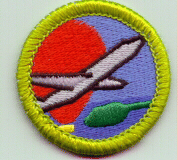 |
 |
| Old Version |
New Version |
AVIATION
These were the REQUIREMENTS before the REVISIONS
made when a new pamphlet was issued during 2006
To see the current requirements
Click Here
REQUIREMENTS had previously been completely REVISED
as of January 1, 2001.
Click Here for the
PREVIOUS requirements.
- Do the following:
- Define "aircraft." Describe some kinds and uses of aircraft
today. Explain the operation of piston, turboprop, and jet
engines.
- Point out on a model airplane the forces that act on
an airplane in flight.
- Explain how an airfoil generates lift, how the primary
control surfaces (ailerons, elevators, and rudder) affect
the airplane’s attitude, and how a propeller produces thrust.
- Demonstrate how the control surfaces of an airplane
are used for takeoff, straight climb, level turn, climbing
turn, descending turn, straight descent, and landing.
- Explain the following: the recreational pilot and the
private pilot certificates; the instrument rating.
- Find out what job opportunities there are in aviation.
Describe the qualifications and working conditions of one
job in which you are interested. Tell what it offers for
reaching your goal in life.
- Do TWO of the following:
- Take a flight in an aircraft. Record the date, place,
type of aircraft, and duration of flight, and report on
your impressions of the flight.
- Visit an airport. After the visit, report on how the
facilities are used, how runways are numbered, and how runways
are determined to be "active."
- Visit a Federal Aviation Administration facility—a control
tower, terminal radar control facility, air route traffic
control center, flight service station, or Flight Standards
District Office. (Phone directory listings are under U.S.
Government Offices, Transportation Department, Federal Aviation
Administration. Call in advance.) Report on the operation
and your impressions of the facility.
- Visit an aviation museum or attend an air show. Report
on your impressions of the museum or show.
- Explain the purposes and functions of the various instruments
found in a typical single-engine aircraft: attitude indicator,
heading indicator, altimeter, airspeed indicator, turn and
bank indicator, vertical speed indicator, compass, navigation
(GPS and VOR) and communication radios, tachometer, oil
pressure gauge, and oil temperature gauge.
- Visit an aircraft maintenance shop. Interview a technician
and report on his/her ideas about aircraft maintenance.
- Create an original poster of an aircraft instrument
panel. Include and identify the instruments and radios discussed
in requirement 2e.
- Do TWO of the following:
- Interview a professional or military pilot. Report on
what you learned.
- Interview a flight attendant. Report on what you learned.
- Interview a certified flight instructor. Report on what
you learned.
- Under supervision, perform a preflight inspection of
a light airplane.
- Obtain and learn how to read an aeronautical chart.
Measure a true course on the chart. Correct it for magnetic
variation, compass deviation, and wind drift. Arrive at
a compass heading.
- Using one of many flight simulator software packages
available for computers, "fly" the course and heading you
established in requirement 3e or another course you have
plotted.
- On a map, mark a route for an imaginary airline trip
to at least three foreign countries. Start from the commercial
airport nearest your home. From timetables (obtained from
agents or online from a computer), decide when you will
get to and leave from all connecting points.
- Build and fly a fuel-driven model airplane. Describe
safety rules for building and flying model airplanes Tell
safety rules for use of glue, paint, dope, plastics, and
fuel.
- Assemble a poster (or album) of original photographs
taken while accomplishing the requirements.
BSA Advancement ID#: 25
Pamphlet Revision Date: 2000
Requirements last updated in 2001
|





